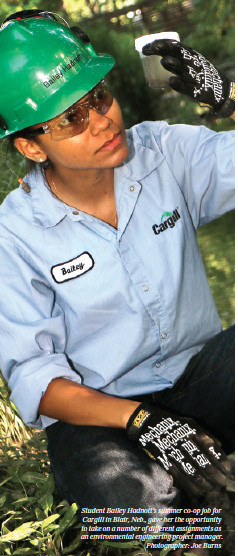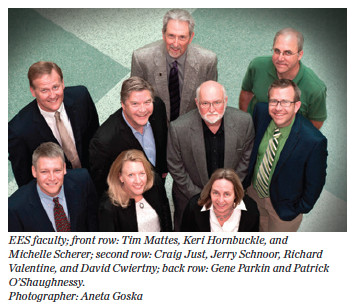By Gary Galluzzo
Everyone likes to be held in high regard by one’s peers.
And the Environmental Engineering and Science (EES) graduate program in the University of Iowa College of Engineering’s Department of Civil and Environmental Engineering is no exception.
Based upon peer assessment by department chairs at civil and environmental engineering departments, the influential U.S. News & World Report 2016 Best Graduate

School Rankings ranks the UI program as 8th-best among U.S. public colleges and universities in the engineering specialty category “Environmental/Environmental Health Engineering.”
Among all public and private institutions, the UI program is ranked 15th-best — only a few places behind such notables as the University of California-Berkeley, CalTech and MIT, who rank 1st, 8th and 10th, respectively.
What did the department chairs see?
First of all, the UI program is nationally known for outstanding research and leadership in a variety of fields, according to Michelle Scherer, professor and departmental executive officer in the Department of Civil and Environmental Engineering. She notes that the high-quality, high-impact research — funded by the EPA, USDA, NSF, NIH and other agencies — spans several areas including:
• Environmental chemistry and biotechnology.
• Pollutant fate, transport and remediation.
• Nutrient management.
• Environmental monitoring and sensing.
• Environmental nanotechnology.
• Water sustainability.
David Cwiertny, associate professor of civil and environmental engineering, points to water research. Cwiertny, whose expertise includes environmental chemistry and water and wastewater treatment, recently published in the journal Science results of a study on the potential environmental impact of steroids and other pharmaceutical products.
The study found that the anabolic steroid trenbolone acetate and other substances don’t fully degrade in water as was once thought. Instead, trenbolone, a federally approved substance for weight gain in cattle, maintains enough residue to regenerate in the environment.
Regarding how his peers view EES, Cwiertny says: “Within our field, EES is looked to as a leader in water related research, and I would broadly classify our collective strength in the area of sustainability of water resources.”
The department chairs responsible for the U.S. News rankings may have also noticed that EES faculty and students are able to quickly apply their specific expertise to new environmental
challenges.
“For example, an emerging area of research relates to the interconnectivity of food, energy and water systems in the United States and around the globe,” Cwiertny says.
“While this is a relatively new research priority in the U.S., several faculty in EES are well-equipped to contribute to the challenge of identifying more sustainable approaches for managing our food, energy and water resources.”
EES is also committed to studying very difficult and long-standing issues of environmental concern. UI Professors Tim Mattes and Jerry Schnoor recently published research results showing a potentially cheap, effective and environmentally sound method for reducing PCB levels in PCB-contaminated soils and water.
PCBs were once widely used for such purposes as electrical cooling units and electric cable insulation before they were found to be health hazards. The U.S. Congress banned their manufacture in 1979, but PCBs are still produced inadvertently in some chemical manufacturing processes and are widely distributed throughout the environment.
In a paper published in the journal Ecological Engineering, Schnoor and Mattes showed that a species of switchgrass (Panicum virgatum) planted in the presence of
an aerobic, PCB-oxidizing microorganism (LB400 bacteria) can remove nearly one-half of some PCB contaminants from soils.
Mattes says it was a surprise to find that the presence of switchgrass, once commonly found on the American prairie, appears to enhance the survival and activity of the bacteria. Schnoor says that while researchers often use plants to remove pollutants from soils — where they hope the proper bacteria develop on their own, it was a new twist to the story for the UI researchers to purposefully introduce bacteria at the time of planting.

Regarding the history of the EES program, Schnoor traces its lineage to Civil Engineering, one of the earliest UI engineering degrees and listed in a 1905 UI catalog. But EES actually grew out of a public health emphasis with an undergraduate track in Sanitary Engineering offered by faculty in the Colleges of Engineering, Medicine, Chemistry, and the Hygienic Laboratory in 1923. Master’s degrees and doctorates in Sanitary Engineering were conferred beginning in 1927
and 1939, respectively.
“As one of the earliest programs in the country, it was considered highly successful with many graduates through 1970,” Schnoor says. “In 1970 or so, the title of the graduate degrees was changed to Environmental Engineering and administered by a separate graduate program. In the 1980s, the graduate program in Environmental Engineering was subsumed into the new Department of Civil and Environmental Engineering, and the graduate subtrack was renamed as Environmental Engineering and Science to reflect its interdisciplinary nature.
“The graduate program and subtrack in Environmental Engineering and Science has grown from five full-time faculty to nine today and represents one of the top ten public graduate programs in the country,” Schnoor says.
Another example of recent research drawing widespread attention to EES involves work by Craig Just, assistant professor of civil and environmental engineering. Just attaches wireless, electronic sensors to the shells of mussels living in Iowa rivers and streams. The idea is to learn how open or closed the shells happen to be at any one time, thereby indicating how much algae, bacteria and other organisms the mussels are drawing from the water to use as food. The more open the shells, the more food the mussels are taking in, and the cleaner the stream — especially when the mussels are present in large numbers.
Just hopes that one day his research also will help lead to much-needed habitat restoration for the mussels.
A combination of honors and long-running research activities have also helped raise EES visibility. For example:
• Professors Jerry Schnoor and Gene Parkin in June received high profile, national awards from the Association of Environmental Engineering and Science Professors for “sustained and outstanding contributions to environmental engineering education, research and practice” and for “a record of excellent teaching, advising, significant research achievements and an outstanding record of influence through mentoring,” respectively.
• Professor Keri Hornbuckle has led a major UI-centered PCB Iowa Superfund Research Project examining airborne PCBs in Chicago and at the Indiana Harbor and Ship Canal for nearly a decade.
• Cwiertny is founding editor and currently serves as editor-in-chief of a new journal, Environmental Science: Water Research & Technology, and, in addition, Professors Schnoor, Scherer, Hornbuckle and Richard Valentine have held editor or associate editor positions at premier scientific journals. Schnoor also served for more than a decade as editor-in-chief of Environmental Science and Technology,
the premier journal in environmental engineering.
• Professors Scherer and Hornbuckle in July were appointed by the College of Engineering to Donald E. Bentley Professorships recognizing, in part, their extensively cited publications and international reputations.
• Professor Valentine was the focus of an environmental chemistry symposium held in his honor at the Fall 2014 American Chemical Society national meeting in
San Francisco.
• Cwiertny and Hornbuckle hosted an international conference on emerging contaminants (EmCon 2014) at the UI last summer. Hornbuckle, professor of civil and environmental engineering, says that the strength of the EES group involves understanding and reducing human and ecosystem exposure to toxic pollutants.
Best-known for their work on PCBs (polychlorinated biphenyls), Hornbuckle and her colleagues for more than 25 years have studied many aspects of these toxic chemicals in the Great Lakes environment, including emissions, fate and transport, decay and remediation, toxicology, and human/ ecosystem exposure and risk.
During the last decade, the Hornbuckle team was the first to report the widespread presence of a PCB unrelated to the historical production of Aroclors — toxic commercial mixtures that define many U.S. superfund cleanup sites. Called PCB11, this compound was effectively unknown and had not been included in the many research studies of the prevalence and health hazards associated with PCBs.
Hornbuckle, doctoral student Andres Martinez and postdoctoral fellow Dingfei Hu discovered the compound to be present throughout the air of the city of Chicago.
“Prior to our report, PCBs were assumed to be present in the environment as an exclusive result of the use of historical Aroclor use,” says Hornbuckle. “Our discovery showed that other sources of PCBs are out there.”
In addition to faculty research, EES students have brought a good measure of attention to the program by winning national awards, receiving NSF Graduate Fellowships and winning national paper awards for portions of their doctoral theses. Also, EES has a tremendous track record of placing graduate students into faculty positions.
Hunter Schroer, an EES program second-year doctoral student, says, “EES is a program where students are enabled to thrive. The friendly environment encourages collaboration and support, which allows us to do our best work.”
Says Scherer, “The EES group at the University of Iowa has been instrumental in identifying and addressing some of the major environmental issues of the last few decades, as well as training a cadre of young engineers and scientists to promote and engineer a sustainable environment. I have no doubt they will continue to remain highly regarded nationally and internationally.